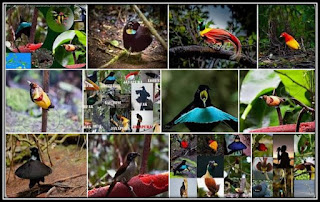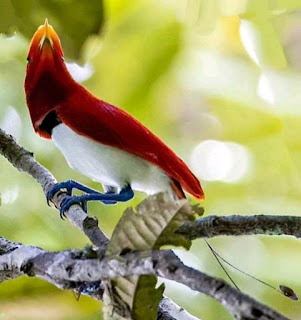Papua Special Interest Adventure
We serve special interest travelers only
Thursday, June 2, 2022
Tuesday, May 31, 2022
Friday, November 12, 2021
Yapen Islands-Serui-Papua
The Yapen group of islands lies directly across the Yapen Strait from Biak, about 40 km’s to the south. The largest of this group is Yapen Island (also known as Japen Island). Mios Num Island lies to the west, Kurudu to the east and off the south coast are the Amboi and Kuran Islands.
Whilst not as popular as the Biak islands, Yapen is the pick of the two if you are looking for a laid back tropical paradise. A number of excellent surf breaks around the islands are relatively unknown; not so the abundant coral reef and wreck dive sites within a stone’s throw of the islands. But you don’t have to be into surfing or diving to enjoy the islands which abound with unspoilt tropical beaches fringing a lush mountainous interior. The World Wildlife Fund as a rainforest ecoregion for its unique bird life and flora has formally recognized Yapen.
Monday, October 25, 2021
Jayapura-Nimbokrang Birds
Papua-Must visit
West Papua makes up the western side of the island of New Guinea and sits north of Australia. It happens to sit on the other side of the invisible biogeographic marker known as Lydekker’s Line, so not only are the people very different, the avifauna found here are nearly unrelated to their “Indonesian” counterparts. I’ve mentioned about Wallace’s Line on one end of the country running between Bali and Lombok and therefore talked about the unique distribution of plants and animals on either side of it. A similar phenomenon occurs on the other side of Indonesia and is known as Lydekker’s Line. Birds of Paradise and other crazy, insane species are found on the other side of Lydekker’s Line and therefore this part of the world is a MUST VISIT for anyone, bird lover or not.
Arfak Foothills Birds Photography
WEST-PAPUA-ARFAK FOOTHILLS BIRDS PHOTOGRPAHY
Wednesday, October 20, 2021
Raja Ampat-Papua
Welcome to Raja Ampat islands Adventures, West-Papua. We are a tour operator company providing you guiding and organizing services for excursions, snorkeling and diving in the islands of Raja Ampat – West Papua Indonesia. Exploring the islands of South Waigeo in the Raja Ampat will offer you a spectacular view of the unique underwater nature and landscape. Known to be the last frontier the Raja Ampat islands have been announced to house the richest reefs in the world. With total fish and coral count which breaks the world record. It is our passion to live close with this nature and share you to feel its magnificent beauty.
Itinerary:
- Day 1 (M, D): Sorong – Misool – Home stay
- Guests are picked up at DEO Airport and then escorted to the speed boat port
- Travel to Misool by ferry
- Lunch on the boat
- Home stay check-in
- Day 2 (B, L, D): Karwapop Love Lagoon – Kaleg – Batu stacking
- Breakfast at Homestay
- Karwapop Love Lagoon
- Lunch break
- Guests are escorted to Kaleg Island to relax on the beach and snorkeling
- Sunset in Batu Susun
- Return to Home stay
- Day 3 (B, L, D): Harfat Peak – Jellyfish Lake – Keramat Cave – Yapap
- Breakfast at Home stay
- Depart to the Dapunlol Peak or better known as the Harfat Peak
- Lunch
- Snorkeling in a jellyfish lake without sting
- Visiting Sacred Goa
- Enjoy the afternoon at Yapap
- Return to Home stay
- Day 4 (B): Misool – Sorong
- Breakfast at Home stay
- Guests are escorted back to Sorong
- Guests are picked up at the port, buy souvenirs and transfer to the airport.
- Tour complete
Should be Brought:
- Swimwear
- Sneakers / sandals
- Gloves
Additional Information:
- Please remember that you have to pay Raja Ampat PIN. Prepare your cash at the location
- Bring the items as needed during the tour. Backpack is highly recommended.
- Unilateral cancellation from guests, then guests are required to find a replacement, otherwise a refund cannot be made
- Trip schedule can change or cancel at any time if there are bad natural conditions and Force Majure. If there is a Force Majure (forced condition is out of control) then it will be discussed together for trip transfers at a adjusted cost.
- Each participant must follow directions from the guide for mutual safety & comfort.
- Participants must be healthy.
Sago Worms-Jayapura
The sago worm (Rhynchophorus ferrugineus) is the larva of
the red palm beetle. It is a nutritious food source which is found in the
remaining parts of a sago palm trunk after the removal of sago starch by
farmers. The insect belongs to the Dryophthoridae family, and genus of
Rhynchophorus, which consists of 10 species, which are found on mainly palm
trees, coconut tree and date palm. This article discusses the nutritional
contents and health benefits of sago worms.
These worms are known to have amazing health benefits. When
cooked and consumed, people say they taste like meat and even chicken. Most of
us may be freaked out at the mention of eating worms and probably wonder how
they can be nutritious. In this article, we will discuss that and much more.
Not all worms can be eaten as their are some which are harmful and others
beneficial, just like the sago worm also known as coconut worm, sago palm
weevil or palm tree weevil.
Nutritional Content of Sago Worm
Sago worm is a very rich source of protein, amino acids, oil,
carbohydrates and minerals. It also contains dietary fiber. [1]
One 2011 research stated that the worm is a rich source of
magnesium, calcium, zinc, iron, potassium, phosphorus, fatty acid, lipid,
dietary fibre and carbohydrate. It also contains fatty acids such as palmitic
acid and stearic acid.
The nutritional composition of sago worm (g/100g dry
weight) are as follows:
·
Protein 25.8g
·
Fat 38.5g
·
Ash 2.1g
·
Carbohydrates 33.2g
·
Energy (kcal) 583
Health
Benefits of Sago Worm (Coconut Worm)
1.
Used in cooking
One
way of getting the optimal nutrients present in coconut worms is through
consumption. As mentioned earlier, these worms have different recipes in which
they can be prepared to suit your taste. They can either be eaten raw, roasted,
fried and even barbecued. They can be added as side dishes or to stew or soups,
whichever way you prefer.
2.
Good for digestion
The
dietary fiber present in sago worms helps in the digestion of food which
prevents the risk of constipation and flatulence. It can also be easily
digested and boosts the metabolism.
3.
Used in pharmaceutical purposes
Simply
put, some of the drugs we consume are made from these worms. Sago worms contain
fatty acids such as linoleic acid, palmitic acid and stearic acid which are
used in many pharmaceutical companies. The worms are also rich in amino acids
such as aspartic acid, arginine, Isoleucine, alanine, lysine and tyrosine.
4. Strengthens the bones and teeth
Sago
worms are rich in minerals like calcium and magnesium, which helps strengthen
our bones and teeth. They can diversify the nutritional intake and give you many
essential nutrients.
5.
Rich source of protein
As
we all know, proteins are really essential to the body. Since sago worms
contain high protein just like eggs, they serve the same purposes. That is,
building worn out tissues and making new ones. A 2017 study investigated the
protein analysis of sago worm, and revealed that the worm had a high protein
content in it’s larvae stage.
Sago
warms have been said to have almost same nutritional protein content as soya.
They also contain low cholesterol.
6.
Reduces blood sugar levels
Coconut
worms are healthy food for diabetics as they are low in sugar and would help
maintain sugar levels. They also help reduce cholesterol levels and reducing
the risk of other diseases.
7.
Fights Microbial Infections
Medical
studies have shown that the worms provides a protective barrier against
microorganisms due to their antimicrobial properties. The worms are said to be
rich in Iron and Zinc.
Conclusion
Sago
worms are a nutritious food source with many health benefits. They can be a
source of food and income for the the peasant farmers in rural areas and
villages. You can add them to your diet today.
Key Words: Sago worm, nutritious, food security, children under five, Indonesia
_______________
Source: ttps://healthguide.ng/health-benefits-sago-worms/
-
BIRDING TRIP, JAYAPURA REGION, SOSIRI VILLAGE, NORTHERN JAYAPURA. During these 2 full days, we will focus on our target birds of the lowland...
-
Welcome to Raja Ampat islands Adventures, West-Papua. We are a tour operator company providing you guiding and organizing services for excu...
-
BALIEM VALLEY Deep Inside of Western New Guinea Explore the last frontier of Indonesia’s remote Papua Island, embark on a spectacular cult...





















































